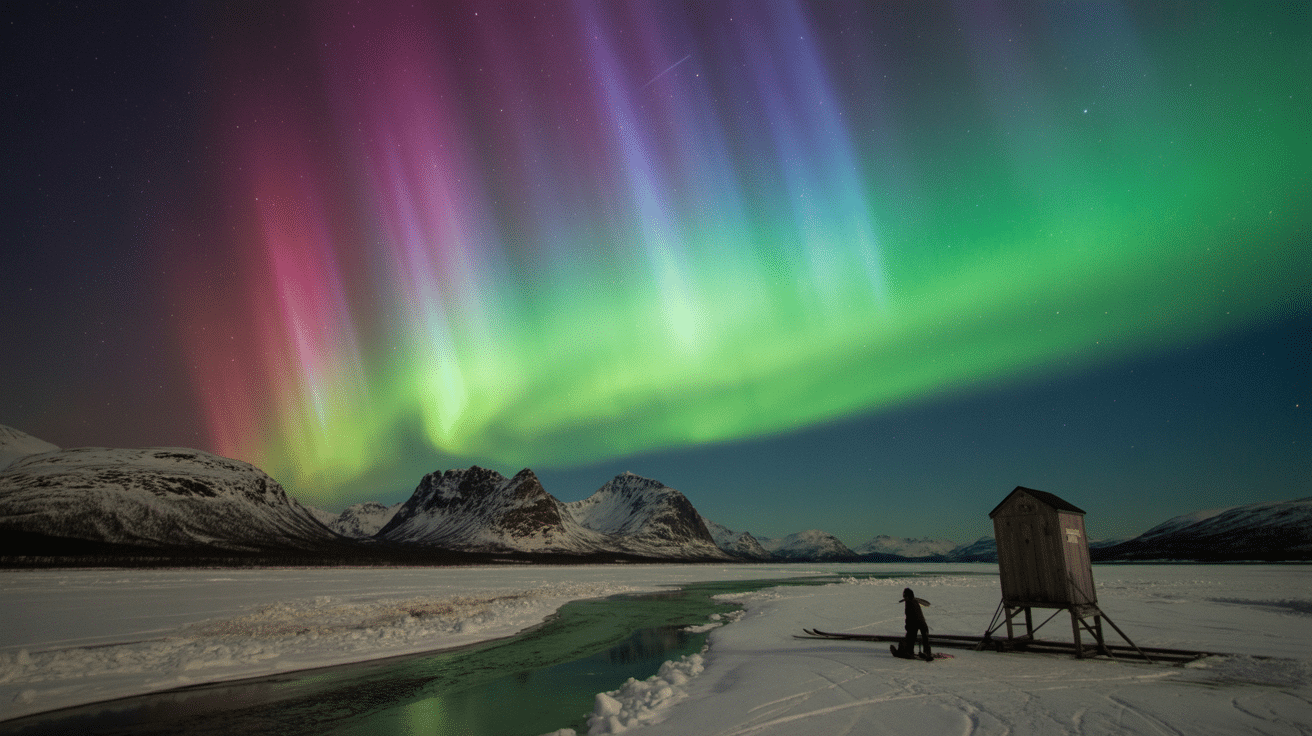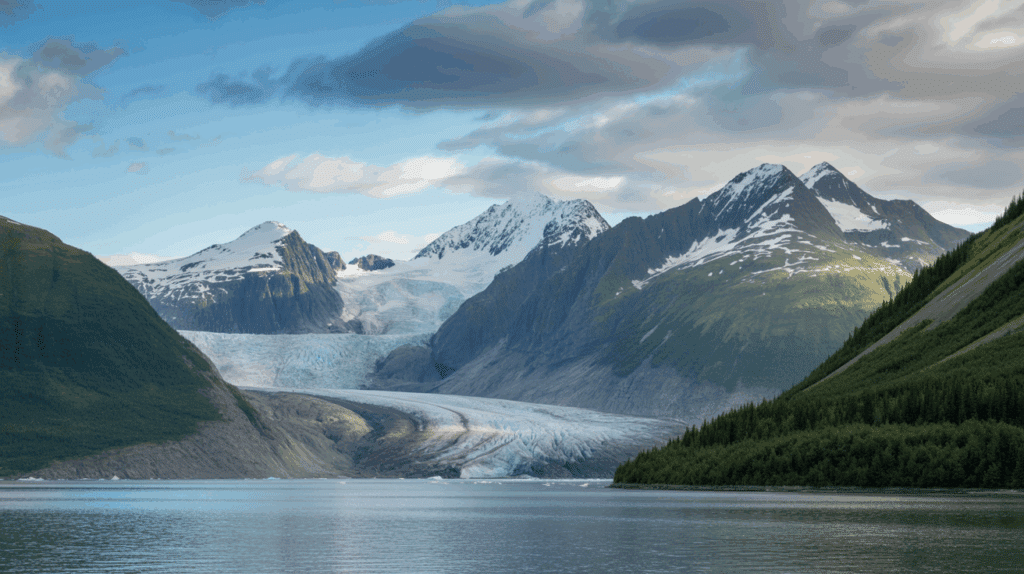Alaska remains one of America’s most mysterious states, and most people know surprisingly little about this vast northern territory.
The Last Frontier holds countless secrets that go far beyond its size and scenery.
This blog post reveals interesting facts about Alaska that will change how readers view this remarkable state.
From wildlife surprises to historical oddities, these facts cover everything from culture to climate, giving readers a complete picture of what makes Alaska truly special.
What Makes Alaska Unique Compared to Other States?
Alaska is truly unique among U.S. states. Its vast size, more than twice Texas, and lack of road connections to the lower 48 make it stand out.
Known for extreme weather, Alaska has months of continuous daylight in summer and months of darkness in winter. Its geography, climate, and wildlife make life there unlike anywhere else in America.
The climate varies greatly across Alaska:
- Cold winters: Most of the state sees snow and freezing temperatures for many months.
- Short summers: Warm weather lasts only a few months in most areas.
- Different regions: The south is milder while the north stays much colder.
Alaska is home to abundant wildlife like bears, moose, and wolves, as well as vast mountains, glaciers, and forests.
Most communities are small and often only accessible by plane or boat. It’s also the only state that pays residents yearly oil dividends, and with its small population, air travel between towns is common.
Interesting Facts About Alaska You Didn’t Know

1. Alaska is home to the northernmost point in the United States known as Point Barrow.
2. The real town of Talkeetna inspired the setting for the show Northern Exposure.
3. The village of Barrow experiences over two months of continuous darkness each winter.
4. Alaska contains a true desert called the Kobuk Sand Dunes.
5. The Aurora Ice Museum near Fairbanks stays open even during summer.
6. Tourists can pan for gold right outside Anchorage.
7. The town of Chicken got its name because locals couldn’t agree on how to spell ptarmigan.
8. Gates of the Arctic is the only national park named after a living person at the time of its naming.
9. Denali was officially renamed from Mount McKinley in 2015.
10. Alaska has more coastline than all other U.S. states combined.
11. Kodiak Island is home to one of the world’s largest subspecies of bear.
12. The Fur Rondy festival in Anchorage features a race using outhouses on skis.
13. Nearly all residents of Whittier live in a single 14-story building.
14. Bethel features a tundra golf course with no grass.
15. There are over 70 potentially active volcanoes spread across the state.
16. Juneau is the only U.S. state capital that cannot be accessed by road.
17. The Northern Lights can appear in the sky up to 240 nights per year in some parts of Alaska.
18. Some parts of Alaska are closer to Russia than they are to the rest of the United States.
19. During winter, one can technically walk from Alaska to Russia via ice between the Diomede Islands.
20. Kennicott is an abandoned mining town that many believe to be haunted.
21. The city of Nome has the world’s largest functional gold pan on display.
22. ANILCA is the largest single land conservation act in American history.
23. Alaska’s Inside Passage was carved out by ancient glaciers.
24. Some glaciers in Alaska are larger than entire U.S. states.
25. The town of Utqiaġvik had a long-standing ban on alcohol sales.
26. Over 130 volcanoes are found in the Aleutian Islands alone.
27. Jade is Alaska’s official state gemstone.
28. The Hammer Museum in Haines is entirely dedicated to the history of hammers.
29. Alaska has its own time zone called Alaska Standard Time.
30. The Tanana River Ice Classic is a lottery based on guessing when the river ice will melt.
31. Moose antlers are commonly used in signs and public decorations.
32. Visitors to Chena Hot Springs can bathe outdoors even when temperatures fall below zero.
33. Russian Orthodox churches are still active in many Alaskan villages.
34. Skagway maintains a historical Wild West atmosphere due to its gold rush heritage.
35. The town of Tok often records some of the coldest temperatures in the country.
36. Alaska’s official state song was written by a thirteen-year-old student.
37. Eagle is the first town to receive U.S. mail each year by dog sled.
38. Valdez is the northernmost ice-free port on the continent.
39. Some Alaskan lakes are so reflective they show perfect images of mountain peaks.
40. The town of Petersburg is often called Little Norway due to its cultural ties.
41. Residents in Gustavus use only P.O. boxes because the town lacks traditional street addresses.
42. Fairbanks can experience more than 21 hours of sunlight during the summer solstice.
43. The 1964 Good Friday Earthquake in Alaska is the most powerful ever recorded in North America.
44. Alaska Natives make up a significant portion of the state’s population.
45. The Iñupiat language has over 50 words describing different kinds of ice.
46. Dog mushing is recognized as the official state sport of Alaska.
47. The Iditarod Trail Sled Dog Race covers over 1,000 miles across snow and wilderness.
48. Alaska has more licensed pilots per capita than any other U.S. state.
49. Some rural students attend school remotely using satellite internet or radio broadcasts.
50. Alaska is home to more than 20 distinct indigenous languages.
51. A strong Filipino community has been present in Juneau for over a century.
52. Traditional dishes include seal oil, whale meat, and fermented fish.
53. Federal law protects the rights of Alaska Natives to practice subsistence hunting and fishing.
54. The Alutiiq people have lived on Kodiak Island for more than 7,000 years.
55. Some areas of Alaska have more brown bears than human residents.
56. In Alaskan folklore, ravens are viewed as wise and trickster spirits.
57. Alaska is the only U.S. state where polar bears are part of the native wildlife.
58. Bald eagles are commonly seen on road signs, rooftops, and trees in many towns.
59. The muskox is one of the oldest living species still roaming Alaska.
60. Sitka black-tailed deer can often be seen swimming between islands.
61. Legal wolf hunting is still permitted in certain Alaskan regions.
62. Walrus gatherings on coastal shores are a common sight in late summer.
63. During salmon season, rivers fill with so many fish that the water seems to flow red.
64. The Alaska Native Heritage Center educates visitors about tribal languages and traditions.
65. Ice fishing is a common winter activity across the state.
66. Many Alaskans grow vegetables in greenhouses to supplement their food supply.
67. Reindeer are domesticated and raised in some parts of Alaska for food and festivals.
68. Children in some remote villages receive bear safety training in school.
69. Fireweed blooms are used by locals to signal the end of summer.
70. Some households still use whale blubber as fuel for heating.
71. A long-term resident of Alaska is affectionately called a sourdough.
72. Potlatches remain important ceremonies for many Native communities.
73. Road signs often warn of moose crossings in high-traffic wildlife zones.
74. Ravenstail weaving is a respected and carefully preserved Native textile art.
75. The World Eskimo Indian Olympics is hosted annually to honor indigenous sports.
76. Mukluks are traditional boots still worn during the harsh Arctic winter.
77. In some villages, snowmobiles transport students to school during heavy snow.
78. Bush pilots routinely fly hundreds of miles between towns without paved roads.
Additional Everyday Wonders and Offbeat Alaskan Facts

79. Grocery prices in remote villages can be two to three times higher than national averages.
80. Highway signs are often used for recreational target shooting.
81. Many banks use aircraft to deliver cash to small towns.
82. Some residents purchase fuel in bulk and store it for the entire winter.
83. Coffee left outside in January freezes slower than a lightbulb.
84. In certain areas, entire homes are transported on sleds during seasonal migrations.
85. Bright colors are painted on buildings to counteract the long winter gloom.
86. Residents often wear full netting to protect themselves from summer mosquitoes.
87. The Yukon Quest sled dog race is considered even more difficult than the Iditarod.
88. Some small towns elect cats or dogs as honorary mayors.
89. There are more floatplanes registered in Alaska than taxis.
90. Some Arctic Circle ATMs are housed inside general stores.
91. Bear spray is a more common personal safety item than pepper spray.
92. It’s not unusual for residents to ski or snowshoe just to reach their mailbox.
93. After the winter solstice, Barrow gains over nine minutes of daylight per day.
94. Wildlife such as foxes and bears scavenge restaurant dumpsters in town centers.
95. Outdoor freezers are often unnecessary because nature provides freezing temperatures.
96. The U.S. Postal Service still uses dog sleds to deliver mail in some extreme cases.
97. Halloween costumes are usually worn over thick snowsuits.
98. Some roads only exist in winter when lakes and rivers freeze over.
99. Local breweries use glacier water to make craft beers.
100. Vegetables at summer fairs grow to enormous sizes thanks to extended daylight.
101. Duct tape is considered an essential item in most households.
102. Some families own houseboats used as summer vacation homes.
103. Bush planes restock libraries in remote communities.
104. Volunteers often help rescue moose trapped in deep snowbanks.
105. Ferries are used as public transportation between island communities.
106. Anchorage hosts a quirky race called the Running of the Reindeer.
107. Garbage bins in Sitka must be bear-proof and securely locked.
108. Outdoor survival classes are a regular part of public school curriculums.
109. Lakes serve as landing pads for air taxis in rural zones.
110. Fairbanks transforms into an art gallery of ice sculptures each winter.
111. Some Alaskan weddings involve snowmobiles instead of traditional limousines.
The Bottom Line
Alaska proves itself as America’s most distinctive state through its record-breaking size, extreme weather, and unique lifestyle.
These interesting facts about Alaska demonstrate how different life can be in the Last Frontier compared to anywhere else in the country.
Whether planning a visit or simply satisfying curiosity, understanding Alaska helps appreciate the diversity that exists within American borders.
The state continues to surprise even those who think they know it well, making it a place worth learning more about.


















